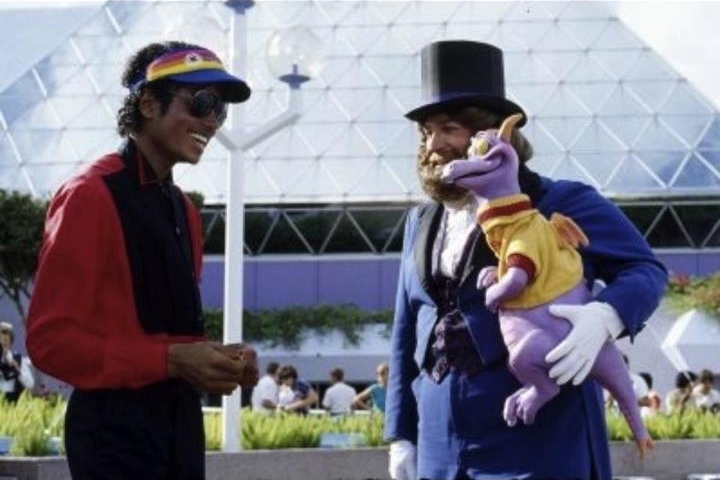Michael Jackson meets Dreamfinder and Figment at EPCOT in the mid 80’s.

Found via Reddit.
The 2,700-acre California estate no longer has amusement park rides or many exotic animals, though the train station is still in place.

The property spans about 2,700 acres and has about 22 structures on it, Ms. Perkins said. The Normandy-style main house, which sits between the property’s two lakes, measures about 12,000 square feet, with six bedrooms plus an attached staff quarters. There’s a four-bedroom guesthouse near the main home and a two-bedroom guesthouse a little farther away. There’s also a swimming pool with a cabana, a barbecue area, basketball court and a tennis court. A 50-seat movie theater has a private viewing balcony, and a stage includes trap doors for magic shows.
Captain EO may not be at EPCOT much longer based on what’s happened to it at Disneyland. I’m glad I got to see it both at Disneyland and Disney World. I’m really glad I got to watch it sitting next to my mom, who loved it a lot.
Here’s one track from EO, called We Are Here to Change the World.
If you have time, watch the full video of Captain EO.
When I received my first CD player in Christmas of 1992 I got R.E.M.’s ‘Automatic for the People’ and Rod Stewart’s ‘Vagabond Heart.’ My mom picked out the Rod album and my older sister suggested the R.E.M. CD. I remember walking through a store with my dad and seeing Michael Jackson’s ‘Dangerous’ CD on display and asking if I could have it. It was the third CD in my “collection” and I was so happy to replace the cassette that I had spent countless hours fast forwarding and rewinding certain songs that I wanted to play over and over again. I was also happy to have book-style liner notes as I had cracked the seams reading tiny lyrics on the cassette insert and it was in a mangled mess. Look at the tiny print.
I already knew the album front to back, but the CD would allow me the ability to skip skip skip and skip back skip back, saving me a lot of time. MTV actually played music videos around that time and I would catch the occasional Michael Jackson ‘Dangerous’ short film. He didn’t make music videos, he made short films (Thriller, Black or White, Remember the Time). I was also about to join the Michael Jackson Fan Club and begin styling my signature, specifically the ‘M,’ like Michael Jackson’s. I still do to this day.
 I’m currently reading Susan Fast’s 33 1/3 series book about and titled ‘Michael Jackson’s Dangerous.’ Susan Fast gets this album. She breaks it down in several parts, explaining why it was a great Michael Jackson album, if not the greatest, and explaining why it was not successful for the mainstream. It’s a great look at a great Michael Jackson era which spanned the Oprah Winfrey interview, the assaulting “sexy panther back alley dance/destruction short” on the full length Black or White video, the Super Bowl XXVII half-time show during which he was catapulted on to the stage dressed in a gold and black military outfit and sunglasses. He remained motionless for a minute and a half, the crowd cheering, and then sang lip-synced four songs. Also, this span covered Jackson’s Heal The World humanitarian efforts.
I’m currently reading Susan Fast’s 33 1/3 series book about and titled ‘Michael Jackson’s Dangerous.’ Susan Fast gets this album. She breaks it down in several parts, explaining why it was a great Michael Jackson album, if not the greatest, and explaining why it was not successful for the mainstream. It’s a great look at a great Michael Jackson era which spanned the Oprah Winfrey interview, the assaulting “sexy panther back alley dance/destruction short” on the full length Black or White video, the Super Bowl XXVII half-time show during which he was catapulted on to the stage dressed in a gold and black military outfit and sunglasses. He remained motionless for a minute and a half, the crowd cheering, and then sang lip-synced four songs. Also, this span covered Jackson’s Heal The World humanitarian efforts.
In this book, the 100th entry in Bloomsbury’s 33 1/3 series, each one devoted to a single album, Ms. Fast employs close readings of lyrics, musical production choices and video presentations to underscore little discussed aspects of Jackson’s creative output.
Ms. Fast contends that, at around this time, lurid media interest in Jackson’s perceived oddity began to eclipse formal appreciation of his work. So she breaks “Dangerous” into thematically rich sections: Jackson breaking with his old self, then switching to familiar modes to make bold political statements and then coming full circle. She praises his use of nonmusical sounds as narrative devices, and contends that Jackson, often painted as resisting the cutting edge, was in fact borrowing some of hip-hop’s angst and reformatting it on his terms.
‘Dangerous’ is such a fantastic album. Succinctly, here’s a portion of Stephen Thomas Erlewine’s review of Dangerous:
Dangerous captures Jackson at a near-peak, delivering an album that would have ruled the pop charts surely and smoothly if it had arrived just a year earlier. But it didn’t — it arrived along with grunge, which changed the rules of the game nearly as much as Thriller itself. Consequently, it’s the rare multi-platinum, number one album that qualifies as a nearly forgotten, underappreciated record.
If you were to ask me which is my favorite Michael Jackson album I might say ‘Off The Wall’ as it’s a complete work of genius. I might say ‘Thriller,’ because a lot of people do. I might even say ‘Bad’ if I think a little longer. I might say ‘Dangerous’ out of a nostalgic remembrance of the obsessive listening and memorization of the album.
I might say Disc 2 of ‘HIStory‘ as it seems to be the album I play the most. A lot of people, though, had already given up on Jackson by the time ‘HIStory’ was released and have no idea what music or album I am talking about. It was after sex scandals, weird marriages of convenience, and the always popular “skin bleaching” topic. It was the album that came out when Michael Jackson was the butt of many jokes. It birthed songs like ‘This Time Around‘ which features Notorious B.I.G., ‘Scream‘ with sister Janet, the gorgeous ‘Stranger in Moscow,’ ‘Tabloid Junkie‘ (my personal favorite), ‘Money‘ (with its eargasmic chorus), and ‘You Are Not Alone.’ There is so much good music on that record. On HIStory, Jackson is furious, lashing out, paranoid, vindictive, and out for blood. Read the New York Times review of HIStory from 1995 titled, ‘Michael Jackson Is Angry, Understand?‘
I’d love to see Susan Fast break down HIStory. I’ve read numerous times that ‘Dangerous’ was Michael Jackson’s fall from grace album. If that’s the case, and that is highly arguable as explained in Fast’s book, then ‘HIStory’ is his Phoenix album where Jackson rises from the ashes.
“There are two kinds of people in this world: Michael Jackson fans and losers.”
Whitney Houston’s funeral was today and I watched Stevie Wonder’s performance of a modified “Ribbon in the Sky.” It reminds me of him giving an amazing performance at Michael Jackson’s funeral.
At which funeral will he sing next? More importantly, who will sing at his funeral? Who is going to give the “Stevie Wonder performance” at Stevie Wonder’s funeral?
1979, the year of Off the Wall and his first nose job, marks an obscure crisis. Around the start of that year, they offer him the gay lead in the film version of A Chorus Line, but he declines the role, explaining, “I’m excited about it, but if I do it, people will link me with the part. Because of my voice, some people already think I’m that way—homo—though I’m actually not at all.”
GQ article, September 2009.
Back to the Future was easily my favorite film trilogy growing up, with Back to the Future II being my absolute favorite. I was amazed by the future. I wanted to go to the future, and get clothes that would shrink to me, and shoes that would lace themselves, and a hoverboard. Oh, a hoverboard. I dreamt of the hoverboard nightly and swore that they’d be released to the general public. I wanted to break my neck on one so badly.
In Back to the Future II, we see Marty McFly go to the year 2015, and it is HELLA AWESOME. (For the full plot, check here. Also, watch the original trailer.) We watch Marty venture out into central square of Hill Valley from the side alley where he and Doc arrived in the flying DeLorean. There are cars taking off into the sky, hoverboards, people looking futuristic, and a 3-D movie advertisement for JAWS that appears to eat McFly whole. Again, it is HELLA AWESOME.
My favorite part is where he ventures into Cafe 80’s and we see a video waiter taking orders. It’s Michael Jackson. And he’s trying to sell a girl a fajita tortilla pita.
“Try our La Bamba fajita tortilla pita. It’s got a hot salsa, avocados, cilantro mix, with your choice of beans, chicken, be-be-beef, or pork…”